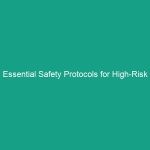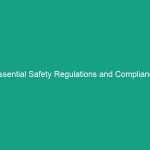Introduction
Good morning team,
Today, we are diving into an essential topic that impacts every member of our workplace—how to identify the weakest link on your team concerning Safety Guidelines. Understanding this concept is crucial because even one individual’s oversight can lead to serious consequences for everyone. By addressing the weakest link, we can strengthen our overall Safety culture, ensuring that we all return home safely at the end of each day.
Understanding the Weakest Link
The term “weakest link” in a team setting refers to the member whose actions or lack of adherence to Safety protocols can jeopardize the entire team’s safety. It’s not about pointing fingers, but rather understanding how we can collectively improve our safety practices.
Recognizing the weakest link is vital for Workplace Safety as it directly impacts our daily operations. For instance, if one team member neglects to wear appropriate Personal Protective Equipment (PPE), it not only puts them at risk but can also endanger their colleagues. Common misconceptions involve assuming that safety is solely the responsibility of management or that one person’s actions don’t significantly affect the group.
Key Hazards, Risks, and Safety Considerations
Identifying the weakest link requires us to be aware of specific Hazards and risks associated with our work Environment. Here are a few critical areas to consider:
- Inadequate Training: If team members lack proper training, they may unknowingly bypass safety protocols.
- Complacency: Over time, employees may become complacent, leading to unsafe behaviors.
- Poor Communication: Lack of communication regarding safety updates can leave team members unaware of potential hazards.
- Insufficient Resources: When safety equipment or resources are lacking, it puts everyone at risk.
The real-world consequences of ignoring these risks can be severe, leading to accidents that result in injuries, financial losses, and even legal repercussions. A single incident can have a ripple effect, impacting not only the individuals directly involved but also the entire team.
Best Practices, Procedures, & Actionable Advice
To address the weakest link in your team, consider implementing the following Best Practices:
1. Regular Training and Refresher Courses
Ensure that all team members receive thorough training on safety protocols and conduct regular refresher courses to keep everyone updated on Best Practices. This can help mitigate the risk associated with inadequate training.
2. Promote Open Communication
Create an environment where employees feel comfortable reporting unsafe behaviors or conditions. Encourage team members to voice their concerns, which can help identify potential weak links before they lead to incidents.
3. Conduct Safety Audits
Regularly conduct safety audits to assess compliance with safety protocols. Use these audits to identify areas for improvement and recognize those who are upholding safety Standards.
4. Foster Team Accountability
Encourage team accountability by having members look out for one another. Implement a buddy system where team members check each other’s PPE and safety practices, reinforcing a culture of safety.
5. Celebrate Safety Achievements
Recognize and celebrate safety milestones as a team. This can motivate employees to prioritize safety and maintain high standards of compliance.
Case Study: Learning from Incidents
Let’s look at a brief real-world incident to illustrate these points:
In a manufacturing plant, a worker failed to secure a safety guard on a machine because they were rushing to meet a deadline. This oversight led to a severe accident that resulted in injury. After the incident, it was discovered that the employee hadn’t received proper training on the importance of safety guards and felt pressured to work faster without considering safety protocols. Following this incident, the company implemented mandatory safety training sessions and encouraged open communication about workloads and safety concerns.
Regulations, Standards, and Compliance
Compliance with Regulations such as OSHA (Occupational Safety and Health Administration) standards is critical for Workplace Safety. These regulations are designed to protect employees and ensure safe working conditions. Failure to comply not only endangers lives but can also result in hefty fines for the company.
Understanding and adhering to these standards is essential for creating a safe work environment. Regular reviews of safety policies in line with established regulations can help identify potential weak links and bolster overall safety culture.
Employee Engagement & Discussion
Now, let’s open the floor for discussion. Here are a few questions to consider:
- What safety challenges have you encountered related to your tasks?
- Have you noticed any safety practices that could be improved within our team?
- What additional resources or training do you think would help strengthen our safety culture?
Engaging in this dialogue is crucial for identifying the weakest link and ensuring that everyone is on the same page regarding safety practices.
Conclusion & Key Takeaways
In conclusion, identifying the weakest link on your team is essential for fostering a safe work environment. By understanding potential hazards, promoting accountability, and ensuring compliance with safety regulations, we can work together to strengthen our safety culture.
Remember, safety is everyone’s responsibility, and by applying these practices, we not only protect ourselves but also our colleagues. Thank you for your attention and commitment to safety. Let’s make today a safe day!


